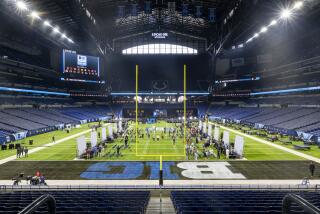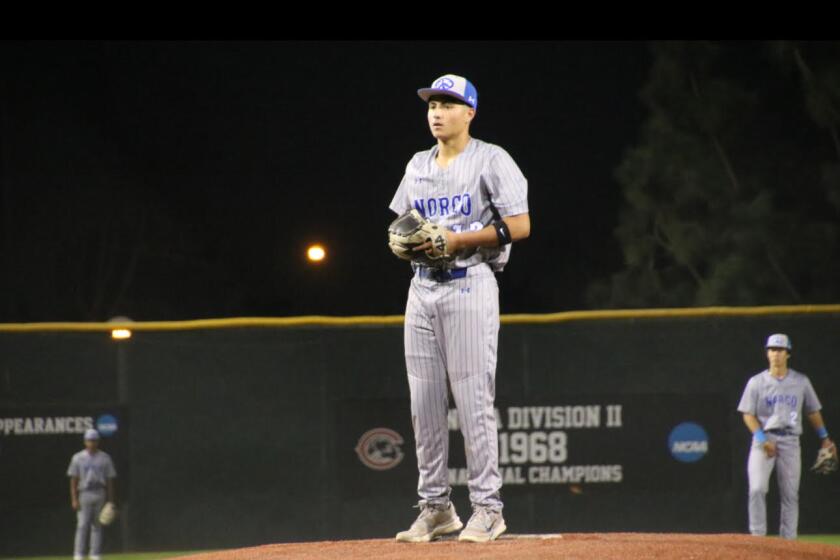NBA Minor Leagues May Cause Major Problem
- Share via
WASHINGTON — All hell is about to break loose in the basketball world. With the NBA planning to start a developmental league for college-age players, the landscape of organized basketball will change dramatically, with the seriously affected parties including high schools, colleges, the NCAA, the NBA, the CBA, television partners, corporate sponsors, sports agents and street hustlers.
This seismic shake-up will be felt because the NBA feels it has to do something to address the issue of younger, and often unprepared, players wanting to enter its ranks. Dozens of the nation’s most talented teen-agers who each year have been pushed into, and sometimes through, college because it was the only path to a career in professional basketball, apparently will have an alternative that is essentially a minor league basketball system run by the NBA.
And as a result, the CBA will be hard-pressed to stay alive, the TV networks will have to find room in an already crowded field for more basketball programming, sports agents will routinely recruit high school players, and the NCAA will be forced to confront its own hypocrisy, which helped create the environment that forced the NBA’s hand.
“On the surface, it seems this is certain to really change the landscape,” a Division I athletic director said Thursday. “To what degree, no one could possibly know, which is what makes the whole thing so frightening. It’s a mess, a huge mess. The NBA and college basketball have been able to co-exist because there are some demographic differences. But at what point is the field too crowded? How many different ways can the pie be sliced? Do (the colleges) lose market share? Is there some loss of interest? We have to face the fact that because the NBA is the guarantor, this developmental league will have the best advertising, the best launch imaginable, the best of everything. It will have instant credibility because, like the WNBA, they’ll put all their muscle, all their human resources behind this. They’ll send a message: This matters.”
It’s not every day you see college basketball get blind-sided during March Madness, but this is potentially a big blow. The purist will argue, with great merit, that an NBA developmental league could be a blessing for college basketball because it will attract many of the kids who want no part of pursuing an education in the first place, and basically come to college because it has been the traditional path to a career in the NBA. That would open scholarships for kids who might never play professionally, but who would actually have an interest in going to school.
Of course, nothing about college athletics is pure, which is why you will now hear college administrators proclaiming how well NCAA schools prepare kids to play in the NBA. John Thompson talks all the time about how the NCAA and its members preach education and vote money. Just look at the NCAA men’s basketball tournament. Maryland and GW, among many other schools, have been shipped 3,000 miles from home for two weeks, meaning no classes. Why? For the purposes of seeding teams, which is done for television, which pays the NCAA billions to televise this tournament.
The NCAA continually demonstrates that athletics has a marketplace where the NCAA, schools and coaches are all able to cash in, while offering the student a scholarship. Athletes increasingly, and with the volume turned up, have asked, “Where’s mine?” The answer, in the case of basketball, is the NBA. What was once a trickle is now a flood. Last June, 39 nonseniors (including European players under 20) said “later” to school and attempted to enter the NBA. At least 25 of those players were ill-prepared for the NBA game and for life in the NBA.
College basketball is going to suffer, but I don’t think the sky will fall on it. Of the 318 schools that play Division I basketball, I’d bet 250 will be largely unaffected. And March Madness isn’t going to shrivel up and crawl away. You put a band, cheerleaders and teams in uniforms that say North Carolina, Duke, Kentucky and UCLA out there, people are going to watch. The casual fan doesn’t know Earl Watson from the Duke of Earl.
But the teams who could really be hit are the big programs, the ones that are the guts of the feeding system from college basketball to the NBA. Does Steve Francis go to two junior colleges and then Maryland, relatively penniless for three years, or to a developmental league where he can make, say, $75,000 or more a year while getting himself ready for the big time?
Implicit in all this is that the NBA’s developmental league games will be on television. A lot. Most of the good players are sophisticated enough to know you don’t go play where you can’t be seen. It’s about money, yes, but it’s about exposure and ego, too. Kentucky on TV, with Dick Vitale calling the games and Digger Phelps in the studio, or Columbus, Ohio, for $1,500 a week but no TV? Unquestionably, the big schools will be in a tug of war with the developmental league. Wouldn’t it be ironic if the NCAA’s only option was to finally pay players? Otherwise couldn’t you just hear NBA Jr. scouts asking a prospect, “You want to go get yelled at by Jim Calhoun for three years and no money or come to us and really learn the NBA game?”
Throw on top of this the NCAA’s pending amateurism legislation proposal, which would allow kids to play, say, two years in a developmental league, but retain two seasons of college eligibility. You know what we could see? College recruiters attending developmental league games, trying to figure out who won’t cut it in the NBA Jr., but might want to come to college.
One reason I’ve always been in favor of kids having to go to college is that while not everybody should go to college, I’d rather see kids forced to go at least for a while, than not going at all. As one college assistant coach said: “A lot of kids take the path of least resistance. From an academic standpoint, this would be the path of no resistance.”
It’s also a path that is going to lead the basketball world into a lot of blind corners, a big mess, and probably a period of chaos before a new order emerges.
More to Read
Go beyond the scoreboard
Get the latest on L.A.'s teams in the daily Sports Report newsletter.
You may occasionally receive promotional content from the Los Angeles Times.










